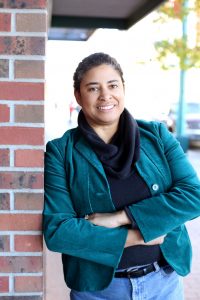
Jenna MacSwain
Based from personal context as a woman who previously worked in Silicon Valley, Jenna MacSwain, scientist and engineer, captures the culture and challenges women faced in the early days of Silicon Valley in her new romantic fiction novel, A Slow Leap Into The Sky.
What was it like for women at CalTech (California Institute of Technology) and in Silicon Valley in the 1980s and 90s? What were the biggest obstacles? How did MacSwain, who held thirteen patents before the age of 23, overcome them? What recommendations does MacSwain have for women entering tech fields, today? I had the opportunity to gain her insight about such questions.
“I was born interested in science, it is who I am,” began MacSwain. “When I was in sixth grade, the Junior High School counsellor came to talk to us about the upcoming academic year and passed out registration cards for our new classes – pink ones for the girls and blue ones for the boys. I crossed out the pre-printed Home Economics and wrote in science.”
High school was STEM-focused for MacSwain, thanks to her determination and ingenuity, and also to an unfunded gifted program that an admired teacher led, which ultimately helped her earn admission to CalTech.
Recalls Swain, “I had taken every math and science class that my high school offered and arranged for independent study for the higher level classes that weren’t offered, and I took calculus at the local university.”
“There was a gulf of difference between what was readily available to me academically and what was available to the average Caltech freshman in 1982, who skewed male obviously but also skewed affluent,” shared MacSwain. “I was determined that if it wasn’t available then I could build it, and that counted for a lot with the admissions committee at Caltech in the 1980s.
Added MacSwain, “It also mattered to the Caltech admissions committee that I wasn’t recruited by them, I sought them out.”
What was CalTech like for women in the early 1980s?
“It was primarily male in 1982, that is trivially obvious and so I will get it out of the way,” explained MacSwain. “There were 42 freshman women in a class of 250 in the fall of 1982. There was a entrepreneurial undercurrent in many aspects of life on campus. Bill Gross was a recent graduate and local entrepreneur in 1983 …. There were so many big ideas just getting started like the human genome project, the re-awakening of interest in neural networks, microprocessors, personal computers.”
MacSwain further explained, “My freshman year I was the only African-American undergraduate woman on campus…. It was what it was, I didn’t know anything different and every one of the incoming freshman class was part of a narrow demographic in one way or another. I attended with a fellow student from my home town, in fact from my high school. We were the first two students from New Mexico to attend Caltech in a decade.”
How did women experience bias in university at the time?
“Running into an assumption by a professor that you couldn’t do an assigned task before you had even started it, … was likely met only by female or minority students. But, at Caltech it wasn’t institutionalized, it popped up on an individual basis. What was institutionalized, at Caltech and in society on a larger scale, was a generalized sense that as women of science we would reach a point where our abilities wouldn’t matter. They would fade into obscurity like our brilliant predecessors that history had erased.”
The world changed while MacSwain was at CalTech.
“By the time I graduated,” described MacSwain, “The sense that we were on the cusp of big ideas was replaced with a sense of the speed of change. The year 1986 saw the adoption of TCP/IP and DNS, and the emergence of internet service providers as ARPANET stepped aside to make way for a public internet.”
MacSwain further recalled, “By 1990 the World Wide Web was an unstoppable force. When I entered Caltech the idea that a computer could be “personal” was a matter of debate. By the time I graduated personal computers were a fait accompli. This accelerating rate of change formed the sensibility of my generation and because of that I made the pace of technology advancement a background character in the novel. “
What was it like for a woman working in Silicon Valley in the 1990s?
“There was a tremendous ecosystem of innovation,” shared MacSwain.
“In 1989, companies were popping into existence as others were winking out. This made for a flow of professional people and a mixing of skill sets, experience and ideas … and an unprecedented availability of equipment and resources. It only took a phone call with a description of the most speculative of projects to get a spec sheet and free copies of a new device from a chip manufacturer.”
“There were warehouses that were like giant garage sales for venture capitalists who had shut down a company. I remember going through one of them looking for lab benches, and finding a nearly new scanning electron microscope for just a little more than the cost of the lab benches.”
What was the biggest obstacle as a women in Silicon Valley in the late 1980s and early 1990s?
“I was never going to be my boss’ “Golden Boy”, the rising star that was supported and promoted because those in power saw in that person their past self or who they had wanted to be. I would never occupy that position in their imagination,” explained MacSwain.
“My personhood in their imagination was most often in some way connected with who they did or did not want to sleep with, or through their relationship with other women in their lives: their wife, their daughter … For the generation before mine, men in positions of authority were used to taking the contributions of women for granted, or worse, taking the credit for them.”
Success strategies for women in STEM.
Prioritizing work experience over mentorship, MacSwain had several strategies to share for women today who are breaking through their own barriers in STEM.
“Find out what you are worth and ask for it, particularly for your first job, … but don’t work for less because that devalues your ability to earn and it level sets your future compensation. Raises will be a percentage of your pay and your next job will look to pay you based on what you made at your previous position, building a system where if you start behind then you stay behind. ”
MacSwain also recommended, “Finding a mentor is a fine starting place, but it is not sufficient; see yourself instead as the candidate of your career and you need to build a team for you campaign.” MacSwain added, “That is more than one person, and more than one role.”
“And, remember, that you don’t need to be a warrior, you are already the agent of change, just as you are – most often you just need to be seen doing what you do. You are normal. You are needed. Bias and discrimination happen, it isn’t your fault, it has happened to all of us in many ways throughout time, but please don’t let it stop you.”
“Lastly, find someone to keep in your life who gives you strength when you get tired.”
Check out A Slow Leap into the Sky.



